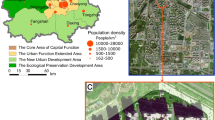Abstract
This heuristic study of the urban morphology influence on urban albedo is based on some 3,500 simulations with the Solene model. The studied configurations include square blocks in regular and staggered rows, rectangular blocks with different street widths, cross-shaped blocks, infinite street canyons and several actual districts in Marseilles, Toulouse and Nantes, France. The scanned variables are plan density, facade density, building height, layout orientation, latitude, date and time of the day. The sky-view factors of the ground and canopy surfaces are also considered. This study demonstrates the significance of the facade density, in addition to the built plan density, as the explanatory geometrical factor to characterize the urban morphology, rather than building height. On the basis of these albedo calculations the puzzling results of Kondo et al. (Boundary-Layer Meteorol 100:225–242, 2001) for the influence of building height are explained, and the plan density influence is quantitatively assessed. It is shown that the albedo relationship with plan and facade densities obtained with the regular square plot configuration may be considered as a reference for all other configurations, with the exception of the infinite street canyon that shows systematic differences for the lower plan densities. The curves representing this empirical relationship may be used as a sort of abacus for all other geometries while an approximate simple mathematical model is proposed, as well as relationships between the albedo and sky-view factors.













Similar content being viewed by others
References
Aida M (1982) Urban albedo as a function of the urban structure—a model experiment. Boundary-Layer Meteorol 23:405–413
Aida M, Gotoh K (1982) Urban albedo as a function of the urban structure—a two-dimensional numerical simulation. Boundary-Layer Meteorol 23:415–424
Arnfield AJ (1988) Validation of an estimation model for urban surface albedo. Phys Geogr 9:361–372
Arnfield AJ (2000) A simple model of urban canyon energy budget and its validation. Phys Geogr 21:305–326
AURAN (2005) Quartiers de villes, Quartiers de vie, Habitat et Formes urbaines (in French). Urbanism agency of the Nantes urban area, 165 pp. www.auran.org/
Christen A (2005) Atmospheric turbulence and surface energy exchange in urban environments: results from the Basel Urban Boundary Layer Experiment (BUBBLE). Doctoral Thesis, Basel University, 140 pp
Grimmond CSB, Salmond JA, Oke TR, Offerle B, Lemonsu A (2004) Flux and turbulence measurements at a densely built-up site in Marseille : heat, mass (water and carbon dioxide), and momentum. J Geophys Res 109:D24101. doi:10.1029/2004JD004936
Groleau D, Fragnaud F, Rosant J-M (2003) Simulation of the radiative behaviour of an urban quarter of Marseille with the SOLENE model. In: Klysik K, Oke TR, Fortuniak K, Grimmond CSB, Wibig J (eds) Proceedings of fifth international conference on urban climate, Lódz, Poland
Hénon A, Mestayer PG, Groleau D, Voogt JA (2011) High resolution thermo-radiative modeling of an urban fragment in Marseilles city center during the UBL-ESCOMPTE campaign. Build Environ 46:1747–1764
Hénon A, Mestayer PG, Lagouarde JP, Voogt JA (2012) An urban neighborhood temperature and energy study from the CAPITOUL experiment with the S olene model. Part 1: analysis of flux contributions. Theor Appl Clim. doi:10.1007/s00704-012-0616-z
Idczak M, Groleau D, Mestayer P, Rosant JM, Sini JF (2010) An application of the thermo-radiative model SOLENE for the evaluation of street canyon energy. Build Environ 45:1262–1275
Kanda M, Kawai T, Nakagawa K (2005) Simple theoretical radiation scheme for regular building arrays. Boundary-Layer Meteorol 114:71–90
Kondo A, Ueno M, Kaga A (2001) The influence of urban canopy configuration on urban albedo. Boundary-Layer Meteorol 100:225–242
Krayenhoff ES, Voogt JA (2007) A microscale three-dimensional urban energy balance model for studying surface temperatures. Boundary-Layer Meteorol 123:433–461
Masson V (2000) A physically-based scheme for the urban energy balance in atmospheric models. Boundary-Layer Meteorol 94:357–397
Masson V (2006) Urban surface modelling and the meso-scale impact of cities. Theor Appl Climatol 84:35–45
Masson V, Gomes L, Pigeon G, Liousse C, Pont V, Lagouarde JP, Voogt J, Salmond J, Oke TR, Hidalgo J, Legain D, Garrouste O, Lac C, Connan O, Briottet X, Lachérade S, Tulet P (2008) The Canopy and Aerosol Particles Interactions in TOulouse Urban Layer (CAPITOUL) experiment. Meteorol Atmos Phys 102:135–157
Miguet F, Groleau D (2002) A daylight simulation tool for urban and architectural spaces—application to transmitted direct and diffuse light through glazing. Build Environ 37:833–843
Oke TR (1987) Boundary layer climates, 2nd edn. Methuen and Co. Ltd., London, 435 pp
Oke TR (1988) Street design and urban canopy layer climate. Energy Buildings 11:103–113
Pawlak W, Fortuniak K (2002) Estimation of the effective albedo of the urban canyon—comparison of the two different algorithms. In: International conference “Man and climate in the 20th century”, Wroclaw, 13–15 June 2002
Perez R, Seals R, Michalsky J. (1993) An all-weather model for sky luminance distribution. Solar Energy 50:235–245
Pigeon G, Moscicki MA, Voogt JA, Masson V (2008) Simulation of fall and winter surface energy balance over a dense urban area using the TEB scheme. Meteorol Atmos Phys 102:159–171
Sievers U, Zdunkowski W (1985) A numerical simulation scheme for the albedo of city street canyons. Boundary-Layer Meteorol 33:245–257
Vinet J (2000) Contribution à la modélisation thermo-aéraulique du microclimat urbain. Doctoral thesis (in French), Ecole Centrale de Nantes and Nantes University, Nantes, France, Caractérisation de l’impact de l’eau et de la végétation sur les conditions de confort en espaces extérieurs, 245 pp
Acknowledgments
Part of this work has been done when the second author was working with the Laboratory of Fluid Mechanics of the Ecole Centrale de Nantes (UMR CNRS 6598).
Author information
Authors and Affiliations
Corresponding author
Rights and permissions
About this article
Cite this article
Groleau, D., Mestayer, P.G. Urban Morphology Influence on Urban Albedo: A Revisit with the Solene Model. Boundary-Layer Meteorol 147, 301–327 (2013). https://doi.org/10.1007/s10546-012-9786-6
Received:
Accepted:
Published:
Issue Date:
DOI: https://doi.org/10.1007/s10546-012-9786-6




